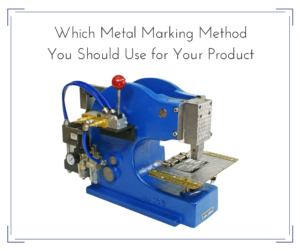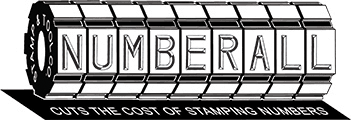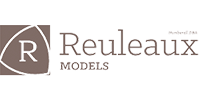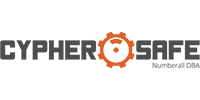Are you new to metal marking? Perhaps you’ve recently discovered that your product, whether it be stainless steel, plastic, or any material in between, needs to be marked with numbers, letters, or symbols. If so, understanding the intricacies of product marking and choosing the right kind for your product may seem daunting. Understanding the differences between marking types can help you determine which metal marking method you should use for your product.

There are various types of metal marking methods, each of which has its advantages and disadvantages. Three popular types of metal marking include indent, chemical etch, and ink marking. At Numberall Stamp & Tool Co., we provide indent marking machines. Our equipment can be used to mark an array of components, such as nameplates, tags, keys, small parts, bushings, round shafts, completely assembled parts, and more.
Indent marking is a permanent method of marking a product – it cuts into the product and can only be removed by destroying the part. Depending on the material to be stamped, indent marking can be done as a cold stamp, or with heat to brand into the product (this is used often on plastic materials). Both methods need pressure to “cut” into the part. Since the mark is permanent it can withstand harsh environments. It can also withstand years of abuse and will not “wear” off unless the part is damaged.
Chemical etching is practical for creating the same mark every time by using a caustic acid and silk screen to burn away a shallow mark on the part. However, the screen will eventually wear out and require replacement. In addition, extreme care must be taken when handling the acid, as it is very caustic. Inkjet marking utilizes a printer that sprays a stream of ink in the shape of a character on the product. It is very fast but also very messy and may not be permanent.
Both chemical etch and ink marking can be removed by solvents, sand blasting or coating (painting) the product. Depending on your product needs, these two methods may be insufficient if they’re in situations where they may be exposed to any of the aforementioned elements. Indent marking, however, cannot be removed with these methods.
The downside to indent marking is that it puts a strain on the product. In fact, indent marking is called destructive marking in some industries. From the force needed to penetrate the material, the product can bend or distort, even with hot stamping. Chemical etch and ink marking methods are considered non-destructive marking. In other words, the design of your product may determine what type is best to use.
So how do you determine which metal marking method you should use for your product? Design as well as the area to be marked is important to consider. Proper clearances are needed for any of the tools to reach into the marking area. In plastic parts, webbing or support ribs under the marking area are needed to prevent the part from deflecting. Chemical etching or ink marking may be difficult, because sometimes the draft angle may allow too much deviation and the tooling cannot properly contact the part. Whereas with indent marking, there may be enough deflection to allow a good impression.
If you’re new to metal marking and need more guidance to decide which metal marking method you should use for your product, reach out to us and we’ll do what we can to help you find the best fit for your product.


